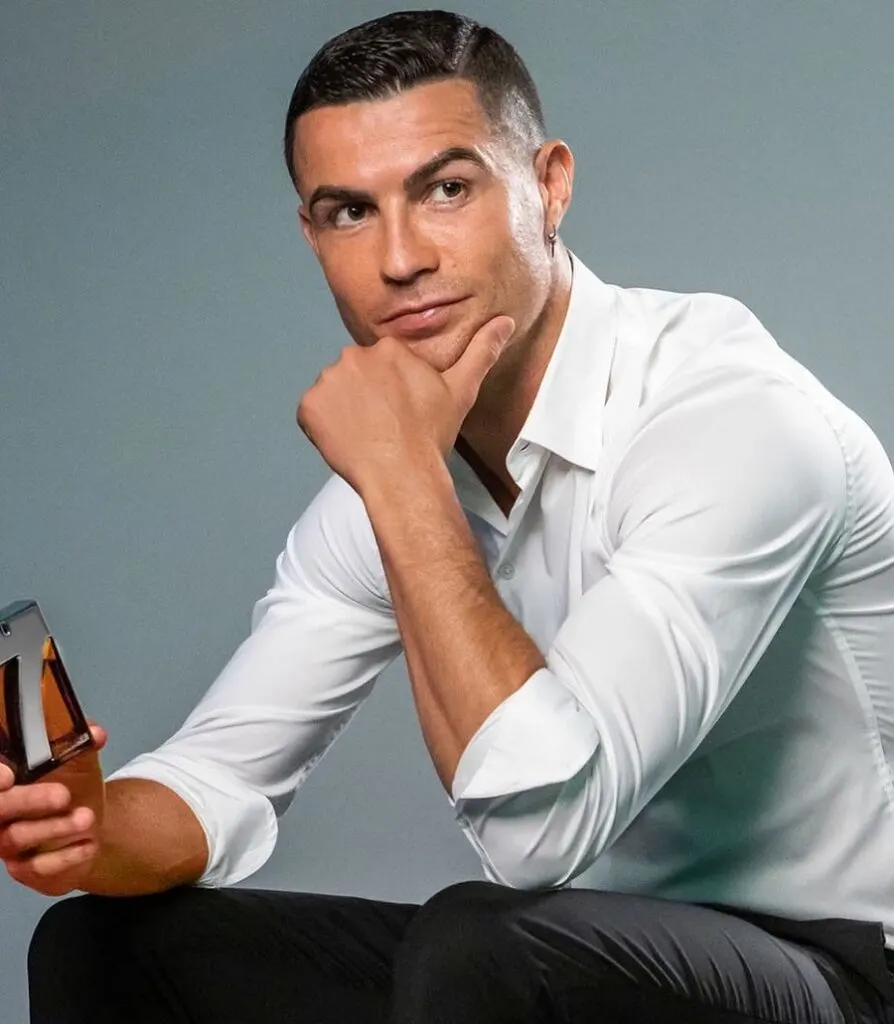If you’re a fan of Cristiano Ronaldo, his hairstyles are sure to be high on your list of favorite moments. As one of the most famous soccer players in history, Ronaldo has had an extensive number of haircuts over the years.
From spiked fringe to painted tips, Ronaldo’s hairstyle has always been a big part of his appeal and he looks good with any haircut.
Cristiano Ronaldo Top Hairstyles & Haircuts
What’s not to love about this Portuguese soccer player? The current Al-Nassr FC player has tons of fans all around the world who are always looking for new ways to show their love for Ronaldo, and copying his hairstyle is one of them. Here are a few of the best Ronaldo haircuts, most of which have been extremely popular.
1. Wavy Slick Back

It is an easy and stylish hairstyle for medium thick hair to rock the summer. You can do it without any effort by applying a light amount of styling product to wet hair and using your fingers to create waves or curls.
2. Nerdy Looks

This hairstyle is very different from the traditional Ronaldo hairstyle that many people are familiar with. This side-trimmed short haircut will give you peace of mind during hot scorching summer days. And if you wear glass, it will be a cherry on top to get yourself a nerdy look.
3. Hard Part

Start by cutting your hair short on the sides and back, but leave the top long. You will then need to section your hair into two parts, forming a hard part on the side. Brush the top part and apply some hairspray to keep the hair in place.
4. High Curly Top

If you want to recreate CR7’s high curly top look, start by sectioning your hair into small curls using a curling iron or heat tool. Then make it wet using hairspray to keep the curls in place.
5. Slick Back Pony

Begin with wetting your hair down before styling it. This will help create a sleek and controlled look. Take the top section and twist it around to form a loop, and pull tight to form a ponytail. Now secure the ponytail with a rubber band.
6.

7.

8.

9.

10.

11. Greasy Hair

If you’re looking to replicate Cristiano Ronaldo’s Greasy Hair hairstyle, then use a pomade or hair wax to create a stronghold in a large section of your hair. Be sure to distribute the grease evenly throughout your hair. Next, use a wide-tooth comb to divide the grease into sections and start combing through your hair.
12. Fade Haircut

Start by getting a haircut that is slightly longer in the front and top and shorter to shave on the side. Next, use some styling hair gel and keep the long hair back with your finger. The gel will hold this style for an extended period.
13. Curls with Blonde Highlights

If you’re looking for a style that’ll make you stand out from the rest, try copying CR7’s blond highlights on your curls. Start by dyeing your hair blonde. Next, curl your hair using hot rollers or curling iron. Finally, style it with hair gel or wax to have a wet look.
14. Short Comb Over

If you’re feeling inspired by the Portuguese superstar and want to achieve a similar look, cut your hair short on the sides and top, then use a comb to smooth down the hair. Finish off with a strong spray of hairspray for extra hold.
15. Disconnected Undercut

First, get a haircut with long hair on the crown and keep them off the forehead. Get a 2.5-1.5 haircut on the side with a wide hairline. Secondly, use a light styling product to disconnect your top hair. Thirdly, evenly distribute the hair around the edges of the head using a hairspray.
16. The spike

This Cristiano Ronaldo haircut is perfect for men with curly hair, which they don’t really like to flaunt. Curly hair is hard to manage and this cut does wonder for keeping it subdued. Cut the hair short and leave some in front to make the spike with the help of some hair gel.
17. Undercut art

Undercuts look wonderful on men with any hair type. This Cristian Ronaldo hairstyle mixes the undercut together with some stylish designs. Shave the sides off completely while leaving some hair on top to experiment with and have your stylist add some design to the shaved part.
Best soccer player hairstyles you will surely love
18. Wild curls

Tired of curls getting in your way and thinking they are impossible to manage? Ask Ronaldo for advice. This haircut is perfect for curly hair, since it keeps it all on top, where it doesn’t need much managing, except maybe some hair gel.
19. Geometrical mohawk

The more hair you shave off, the easier it will be to play football or do anything else for that matter. Don’t want hair to get in your face? Shave it off. Leave some on top to create a mohawk and have some designs on the sides if you wish. This amazing mohawk is likely to become your favorite hairstyle.
20. Spiky fohawk

This Cristiano’s hair gained huge popularity among young teens. Mohawk seems too drastic? No need to force it. You can go for a more suave fohawk by cutting the sides short instead of shaving them. Make a spike on top with the help of some hair gel. You can also leave a little hair on the back to really look stylish.
21. Comb over undercut

An undercut is one of the more popular Cristiano Ronaldo hairstyles since it requires almost no maintenance. The trick to a stylish undercut is playing around with the top part. This haircut leaves the top part long enough to make a nice comb over.
22. Ivy league

Sometimes Cristiano Ronaldo likes going for the classic hairstyles and creates a very sleek ivy league look. No doubt about it, this haircut never goes out of style and looks terrific on any man who tries it. Keep the hair short and neat with the assistance of some hair gel.
23. Playful mess

This is another popular Cristiano Ronaldo haircut that created a buzz. Keeping the hair on top neat is quite complicated if it is long. So Ronaldo has come up with a messy haircut which stays in place even when he is running like the wind. All you need to do is add hair gel and create a mess on top of your head. Make sure to use high-quality gel to keep the mess in place.
24. The wet look

Ronaldo really appreciates wet looks and does a lot of experimenting with them. This hairstyle requires a lot of hair gel and some imagination to keep the comb over neat. Wet looks are great for men with an active lifestyle.
25. Disconnected hairstyle

This disconnected Cristiano Ronaldo hairstyle looks great on men with any type of hair. If your hair is curly, then it will be easily subdued by shaving the sides and leaving about 2 inches on top. If your hair is straight, then keeping it neat will be even easier.
26. Highlights

Some men might think that dyeing hair is not a manly task. Well, they are wrong. Look at how great highlights look on Cristiano Ronaldo. There is no way they make him feel any less macho. Give highlights a try!
27. Asymmetrical look

A gorgeous Ronaldo hairstyle we love. Asymmetrical cuts are quite popular nowadays. They are easy to maintain since there is no need to keep them neat. No matter how you style them or don’t style them, they will always look as though it was meant to be this way.
28. Messy Hair

No, this is not the haircut of his rival, Lionel Messi. As you can see in the picture, Ronaldo sometimes intentionally kept his hair unkempt during his Portugal matches.
29. Creative designs

Shaved sides always allow for the most creative designs. You can go from making small lines to flowers or maps. It all depends on how creative and professional your stylist is. If you don’t want anything too flashy, go for a thick line like the photo.
30. Windblown style

This one is our favorite Cristiano haircut. The top part of the undercut can be styled to look windblown. This is a perfect Cristiano Ronaldo hairstyle since it requires just a little bit of hair gel to look great through the day. Give this windblown undercut a chance, and you might never go back.
31. Rolled Fohawk with Lines

This style embodies Christiano Ronaldo by combining multiple different fashion styles into one hairstyle. Creating a rolled Fohawk mixes up punk style with a Teddy Boy greaser look. The lines give him a modern edge.
32. Spiked Fringe

In this look, Ronaldo has chosen to just spike his fringe up. You can copy his look with just a little bit of holding gel. All that you need to do is run the gel through your fingers, then pull the front portion of your hair upwards into your desired style.
33. Soft Peaks

A very soft central peak in the hair is a super simple style to wear, but it really suits Ronaldo. Put a little product through your hair, and then bring your hands up from the outside of your head towards the middle.
34. Crescent Fringe

To create a crescent-shaped fringe, you will need a small amount of styling gel on your fingers. Bring your hand in from the side rather than from the front. With your fingers in your hair, flick your wrist backwards to create backwards crescents.
35. Painted Tips

Dye the tips of your hair a complementary color which helps to make your hair look sun-kissed. Once your tips are colored, spike your hair up with a little bit of styling gel.
Choose one of the offered Cristiano Ronaldo haircuts, and you are sure to like it. There are different hairstyles for all types of occasions, so you will definitely find the one you need. These hairstyles are all very stylish and are bound to make you look fantastic.
